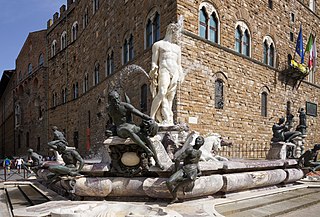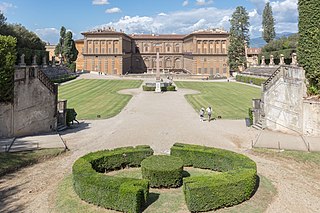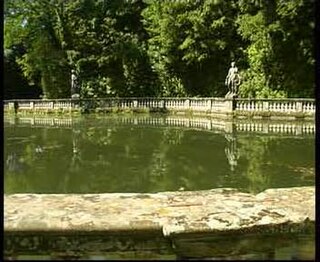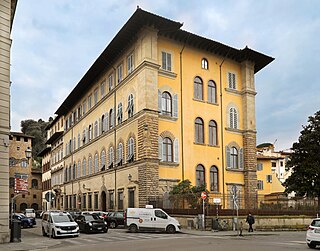

The Villa Torrigiani is located in the hamlet of Camigliano, a town in Capannori (Lucca). It is a historical villa, dating from the second half of the sixteenth century.


The Villa Torrigiani is located in the hamlet of Camigliano, a town in Capannori (Lucca). It is a historical villa, dating from the second half of the sixteenth century.
The first mention of the villa dates back to 1593, as belonging to the Buonvisi family. It was bought later by Nicola Santini, into whose family it passed.
Santini rebuilt the south facade in the Baroque style at the end of the seventeenth century, probably in imitation of the architecture of Versailles where he was ambassador to the Republic of Lucca. The rebuilding involved the addition of two wings to the villa, and the modification of the front by the addition of a massive scale range leading to a serliana, duplicated on the upper floor with two balconies, decorated with statues. He also laid out new gardens. At the front, parterres were arranged around two pools. At the rear, a fountain was built as the focus of the garden, and another sunken 'garden of Flora' was laid out to the east.
In 1816 Victoria Santini married into the eponymous Torrigiani family, who uprooted the existing garden to make an 'English style' park. Only the garden of Flora survived. Now the villa is owned by Fabio Colonna di Stigliano.
The villa stands out from other villas in Lucca and in Tuscany by the multicoloured facade of the main building obtained using different materials: stone grey and tuff alternating yellow pillars and arches, marble statues of white, ochre plaster at the bottom with the upper part in white. Even the use of parapets on the windows or openings are original elements, which are found also at the nearby Villa Mansi. The person responsible for this decoration was the Bolognese architect Alfonso Torregiani. The facade at the back is of late Renaissance style, characterized by a large portico of the Tuscan order.
Inside there is an elliptical staircase, decorated with stucco and other ornamentation. There is a private theatre.

The surviving layout of the garden dates back to the Santini family in 1650.
The main axis of the villa is highlighted by a row of magnificent cypress trees, approximately 700 metres, which complement the facade of the villa. At the end of the avenue, near a majestic gate that enters the house, there is a small village, once intended for the servants.
There is a small garden, enclosed by a network and used as an aviary, a fish farm with jets of water, and the secret garden of Flora with an Italian nymphaeum. The heart of the park is the Nymphaeum of Winds, named for the statues personifying the winds, where the paths converge.
There are a number of giochi d'acqua by means of which the marquis would bemuse unwary guests, chasing them into the garden from the upper terrace. Once there, they would try to shelter in the Temple of Flora, only to find themselves soaked by water pouring from the domed ceiling.
In Florence the house at the Garden Torrigiani is sometimes referred to as Villa Torrigiani. At Scandicci (Florence) there is another Villa Torrigiani in Renaissance style, home today to a winery.

Bartolomeo Ammannati was an Italian architect and sculptor, born at Settignano, near Florence, Italy. He studied under Baccio Bandinelli and Jacopo Sansovino and closely imitated the style of Michelangelo.

The Boboli Gardens is a historical park of the city of Florence that was opened to the public in 1766. Originally designed for the Medici, it represents one of the first and most important examples of the Italian garden, which later served as inspiration for many European courts. The large green area is a real open-air museum with statues of various styles and periods, ancient and Renaissance that are distributed throughout the garden. It also has large fountains and caves, among them the splendid Buontalenti grotto built by the artist, architect, and sculptor Bernardo Buontalenti between 1536 and 1608.

The Villa d'Este is a 16th-century villa in Tivoli, near Rome, famous for its terraced hillside Italian Renaissance garden and especially for its profusion of fountains. It is now an Italian state museum, and is listed as a UNESCO World Heritage Site.

The Villa Giulia is a villa in Rome, Italy. It was built by Pope Julius III in 1551–1553 on what was then the edge of the city. Today it is publicly owned, and houses the Museo Nazionale Etrusco, a collection of Etruscan art and artifacts.

The province of Lucca is a province in the Tuscany region of Italy. Its capital is the city of Lucca.

Villa Barbaro, also known as the Villa di Maser, is a large villa at Maser in the Veneto region of northern Italy. It was designed and built by the Italian Renaissance architect Andrea Palladio, with frescos by Paolo Veronese and sculptures by Alessandro Vittoria, for Daniele Barbaro, Patriarch of Aquileia and ambassador to Queen Elizabeth I of England and his brother Marcantonio, an ambassador to King Charles IX of France. The villa was added to the list of World Heritage Sites by UNESCO in 1996.

Baccio da Montelupo, born Bartolomeo di Giovanni d'Astore dei Sinibaldi, was a sculptor of the Italian Renaissance. He is the father of another Italian sculptor, Raffaello da Montelupo. Both father and son are profiled in Vasari's Le Vite delle più eccellenti pittori, scultori, ed architettori.

The Villa Marlia or Villa Reale di Marlia is a late-Renaissance palazzo or villa, and its estate's property that includes renowned gardens and adjacent villas and follies within the compound. It is located in Capannori, in the Province of Lucca, west of Florence, in the northern Tuscany region of Italy.

The Villa di Castello, near the hills bordering Florence, Tuscany, central Italy, was the country residence of Cosimo I de' Medici, Grand Duke of Tuscany (1519-1574). The gardens, filled with fountains, statuary, and a grotto, became famous throughout Europe. The villa also housed some of the great art treasures of Florence, including Sandro Botticelli's Renaissance masterpieces The Birth of Venus and Primavera. The gardens of the Villa had a profound influence upon the design of the Italian Renaissance garden and the later French formal garden.

Gardens of the French Renaissance were initially inspired by the Italian Renaissance garden, which evolved later into the grander and more formal jardin à la française during the reign of Louis XIV, by the middle of the 17th century.

The Italian Renaissance garden was a new style of garden which emerged in the late 15th century at villas in Rome and Florence, inspired by classical ideals of order and beauty, and intended for the pleasure of the view of the garden and the landscape beyond, for contemplation, and for the enjoyment of the sights, sounds and smells of the garden itself.

Italian garden typically refers to a style of gardens, wherever located, reflecting a number of large Italian Renaissance gardens which have survived in something like their original form. In the history of gardening, during the Renaissance, Italy had the most advanced and admired gardens in Europe, which greatly influenced other countries, especially the French formal garden and Dutch gardens and, mostly through these, gardens in Britain.

The Villa Schifanoia is a historic property that includes an aristocratic mansion and garden in Florence, Tuscany, central Italy, and which has been used as an academic facility by the European University Institute since the late 1980s. It lies near the boundary with the Province of Florence, close to the nearby city of Fiesole.

Villa Bologna is a Maltese stately home, in the village of Attard in the central district of Malta. Built in opulent Baroque style, Villa Bologna has been called "the most beautiful 18th century country house to be built for a Maltese family" and "of similar grandeur to the finest palaces on the island".

Villa Mansi is a country palace and gardens located in Segromigno in Monte, near Capannori, about 12 kilometers northeast of the city of Lucca in the region of Tuscany, Italy.

The Palazzo Nasi, also known as the Palazzo Torrigiani or Palazzo Scarlatti, is a palace located at Piazza de' Mozzi 4, down the street where the Ponte alle Grazie enters the Oltrarno, in Florence, Tuscany, Italy. Another Palazzo Torrigiani Del Nero, with a Mannerist or late-Renaissance-style facade stands closer to the river. Both palaces also once belonged to the Nasi. The palace is a few steps from the Palazzo Mozzi.

The Palazzo Torrigiani Del Nero is a Renaissance-style palace located at Piazza de' Mozzi 5, down the street where the Ponte alle Grazie enters the Oltrarno in Florence, Tuscany, Italy. Another Palazzo Torrigiani stands alongside, the smaller Palazzo Nasi. Both palaces also once belonged to the Nasi.

The Medici Villa of Poggio a Caiano, also called Ambra, is one of the most famous Medici villas and is located in Poggio a Caiano (Prato). Today it is state owned and it houses two museums: one of the historic apartments and the Museum of Still Life.
Villa Mazzarosa is an early 17th-century country palace and gardens located in Segromigno in Monte, near Capannori, about 12 kilometers northeast of the city of Lucca in the region of Tuscany, Italy.